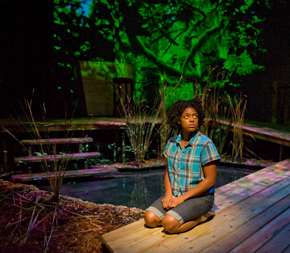
In the Chicago Theater roster of aquatic spectacle, Mary Zimmerman's Metamorphoses first comes to mind. Then, there was Pegasus Players' production of The Frogs in the Truman College swimming pool or The Neo-Futurists' Fake Lake in the Welles Park natatorium. Storefront-circuit regulars might even recall Michael Shannon, Amy Landecker and Guy Van Swearingen wrestling in a spa-sized hip-bath for Red Orchid's Victims of Duty.
The challenge presented in Bulrusher, Eisa Davis' coming-of-age story, lies in the pantheism engendered by its setting amid the pastoral splendor of the Pacific Northwest. Its title protagonist was plucked from the river when only a baby—origins bestowing on her the power to foresee the future. The arrival of a same-sex companion for this feral waif leads to idylls in a hidden cove, where the shoreline dock is overgrown with reeds, grasses and flora of forests primeval. Here, the comrades twice strip to their undies (and none of those transparent-when-wet numbers, either) for a dip in nature's baptismal font before donning their clothes again to face a world not meant for innocents.
Since Davis' script does not specify live water onstage, an easy option for Congo Square Theatre would have been to suggest the riverbank Eden through the use of lights and projections, but director TaRon Patton declared the sight, and sound, and palpable feel of the water intrinsic to the magic necessary in establishing Bulrusher's mystical connection to the source of her birth.
What this means was that scenic designer Andrei Onegin had to figure a way for the stage at the Beacon Street Arts Center to house a bathtub of sufficient volume to allow two athletic young women to frolic in its shallow depths. The answer was a frame constructed from decking-lumber treated with a water-resistant coating, and a plastic-lined basin into which 150 gallons of water is pumped every night before the show. "We use an electric pump, so there's not a lot of labor involved," Onegin shrugs, "It takes about two hours each night."
This is not just any water, however! The design concept also raised questions about the effect on the actors' health after wearing damp clothes in a drafty auditorium for five nights a week. Hospital-grade portable sitz-baths equipped with their own heating mechanisms being expensive, and swim apparel altered to look like underwear proving likewise impractical, the next best option was to fill the tub with hot water.
"Andrei instructed the crew to warm up the pool every night," Patton assures me, noting that the high-wattage incandescent lights aimed at the stage generate warmth as well, "Ericka [Ratcliff] and Tamberla [Perry] also change everything from the skin out during intermission—but I'm sure the water still gets pretty chilly, especially by the second act. Both of them had to acclimate to the temperature in order to maintain the intensity of the scene and the dialogue while pulling on dry jeans and dresses over dripping tank shirts and shorts."
The intensity with which the actresses cleave to one another with virginal passion is unlikely to be diminished by a dip in a tepid mountain stream, no matter how panoramic its surrounding landscape.
Congo Square Theatre's production of Bulrusher runs at the Beacon Street Arts Center through November 25.
Mary Shen Barnidge
Contributing Writer

 Follow Us On Twitter
Follow Us On Twitter